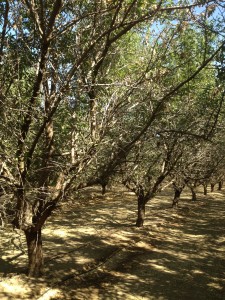I have received several calls and comments regarding the severity of lower limb dieback (LLDB) in almonds this year. This topic has been discussed to a greater extent here, but I thought I would highlight a few points and some updates to keep in mind if you are observing these symptoms in your orchard.
LLDB is used to describe branch death that occurs in the lower half of the canopy. The limbs tend to start the year off normally, but at some point – usually after a hot spell- the leaves on the affected limbs begin to yellow, and eventually the whole branch collapses. Observation of symptoms usually occurs between late May through late July, with symptoms delayed in years with mild springs. LLDB is very common on the ‘Padre’ variety.
So what causes LLDB? The “jury” is still out, but there are a few hypothesis. The current thought is that over-irrigation in the spring followed by under-irrigation during the summer months can worsen or cause LLDB. Over-application of water often occurs in the spring time due to the variable weather conditions (e.g. unexpected cool spells and rain). When it cools off, it is easy to over-apply water especially if the irrigation scheduling is based on the 30 year average. A good example was this past May, in which we experienced an estimated 5.68″ of almond water use (ETc) and had rainfall events that dropped as much as 0.25-1.0 inches of rain in Merced. The 30 year average estimates that we would need to apply 6.44″ of water to match ETc, and if followed, over-irrigation with an inch or more water may have occurred. Furthermore, many orchard operators tend to begin too early with the first fertigation, often beginning before transpiration levels of the tree draw down soil moisture, which keeps the soil too wet during the spring. These periods of over-saturation of the soil impacts root development, reducing the ability to “pull” water later when temperatures increase. In response to this water stress, the tree responds by shutting down the least productive, lower limbs.
Other possibilities that can cause LLDB- especially on varieties other than ‘Padre’- include root or heart wood pathogens, scale, saturated soils from poor infiltration and compaction, or shade out. Heartwood rotters or other root pathogens may have a role by causing a gradual decline of the root structure, which reduces the amount of water that is able to “sucked” into the tree (sound similar to above?). High populations of San Jose or Walnut Scale can cause a gradual decline in wood vigor due to toxins being injected as they feed. Scale problems have become more of an issue in the past years due to lack of dormant sprays. Low rates of infiltration due to poor soil structure or compaction can lead to anaerobic conditions that can kill roots. Shade out is the the natural loss of wood that occurs from limbs receiving less than adequate sunlight, causing a reduction of growth of the shaded limb, and eventual loss of connection to the transpiration stream.
We do not think, at this point, that it is a foliar or canopy disease. Various fungi have been isolated from the affected wood, but researchers have not been able to reproduce symptoms with the identified fungi. Furthermore, multiple year trials conducted by Roger Duncan (Farm Advisor, UCCE Stanislaus) have shown that fungicide spray regimes or dormant sprays does not reduce LLDB.


Hershel
July 26, 2015Lower limb dieback (LLDB) has become an emerging problem within many almond orchards throughout California. University of California Cooperative Extension Advisor David Doll, aka “The Almond Doctor,” has posted an alert on his blog.